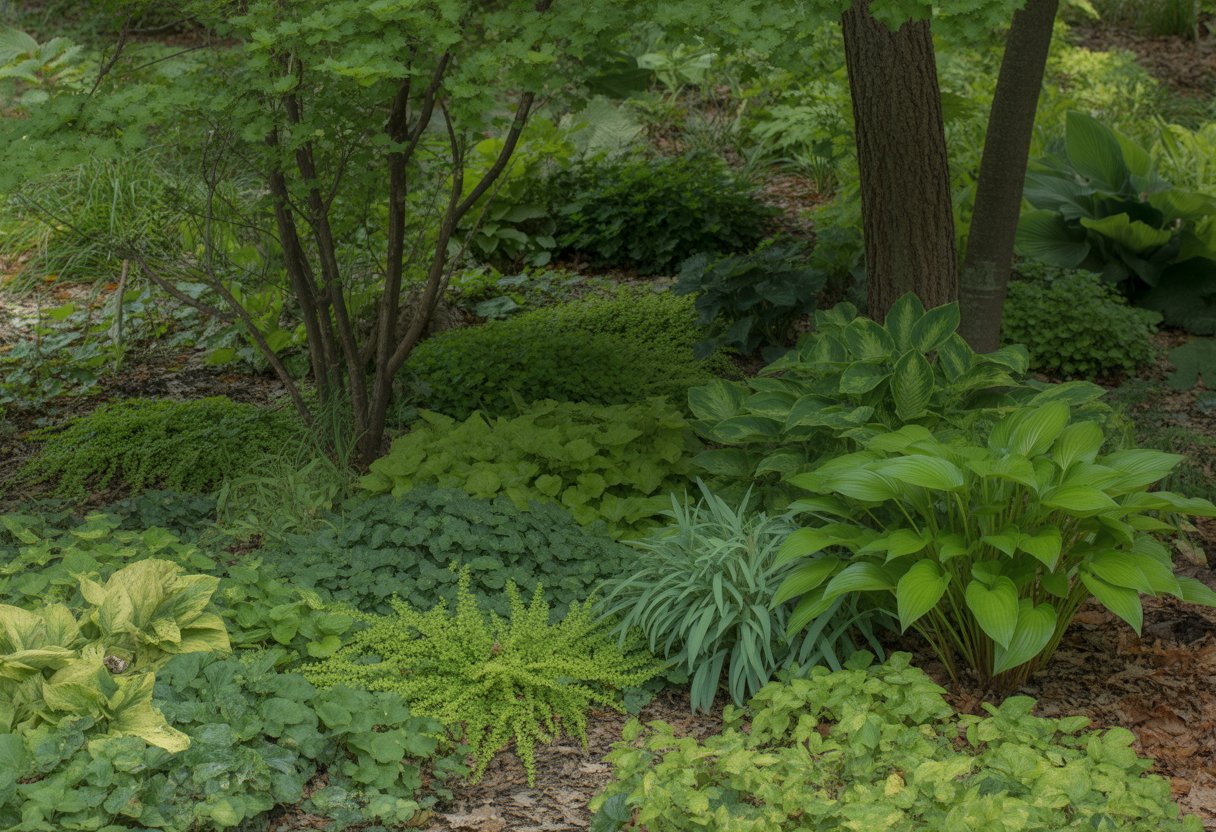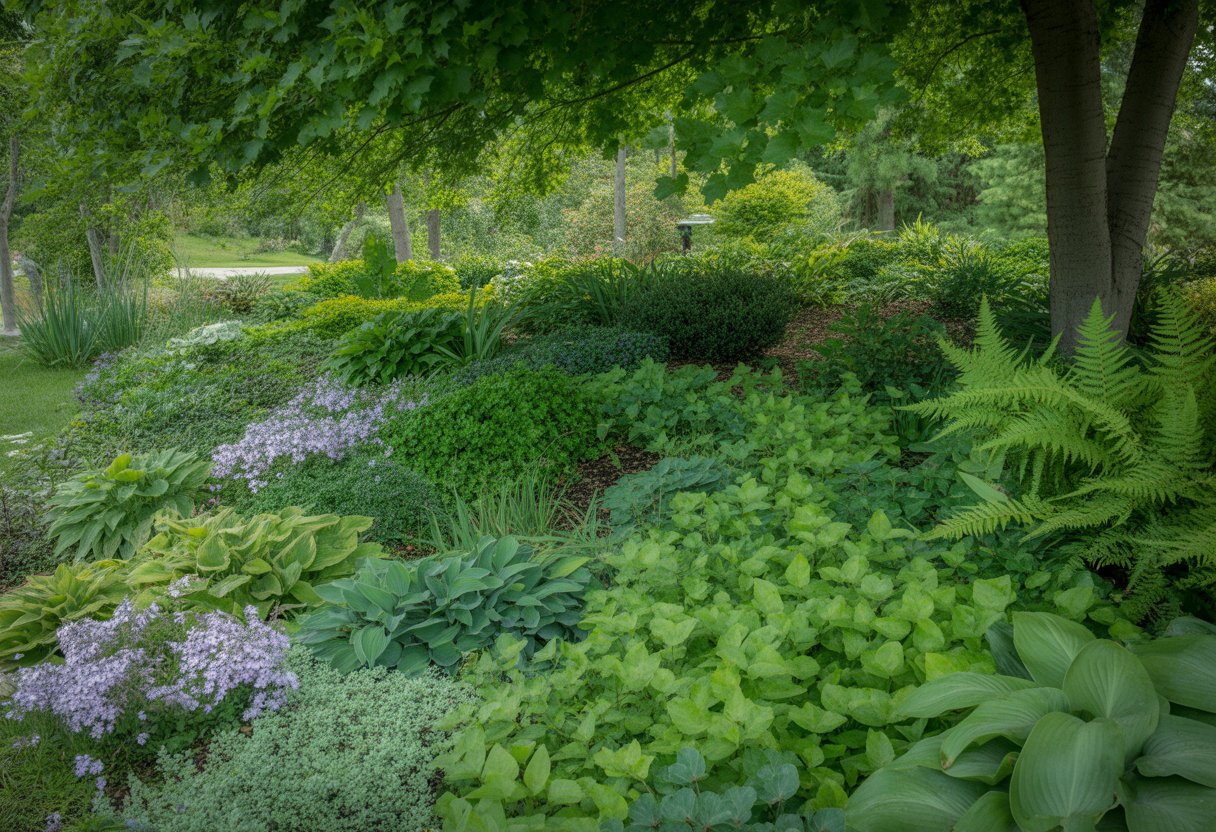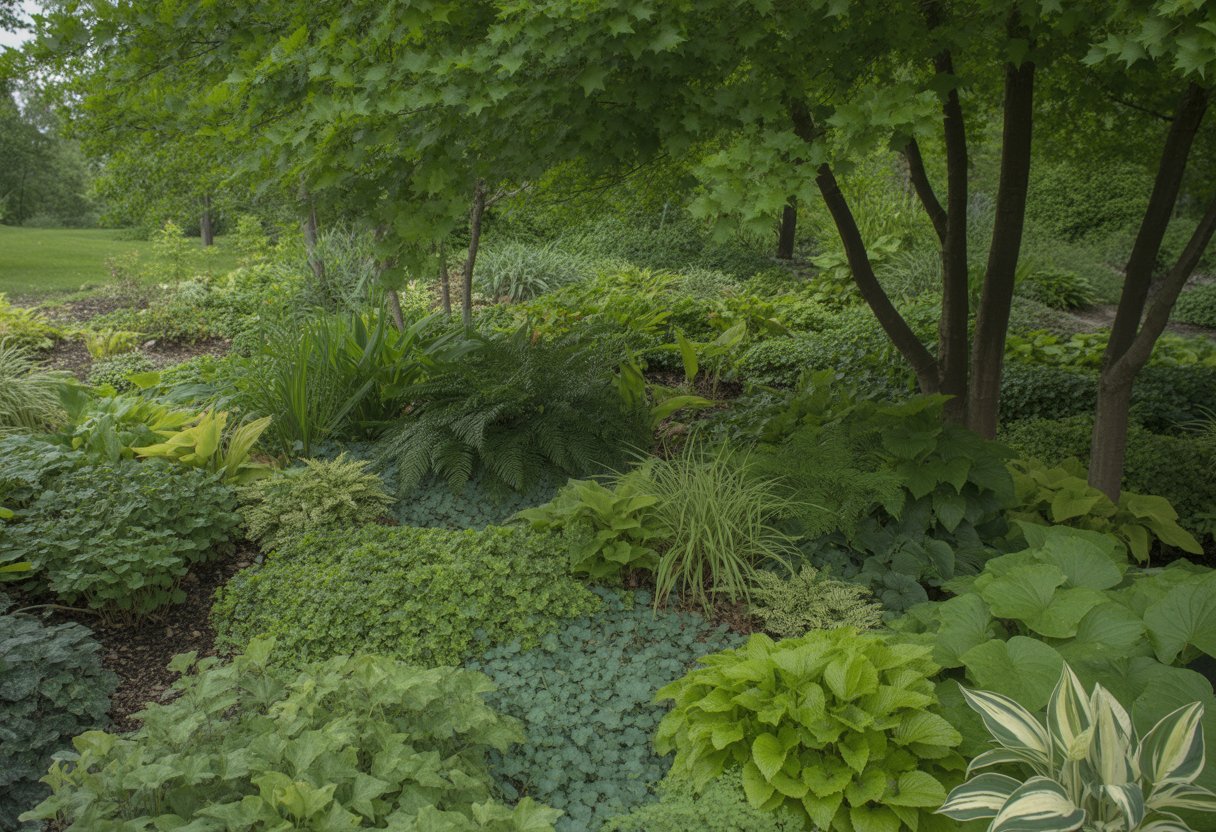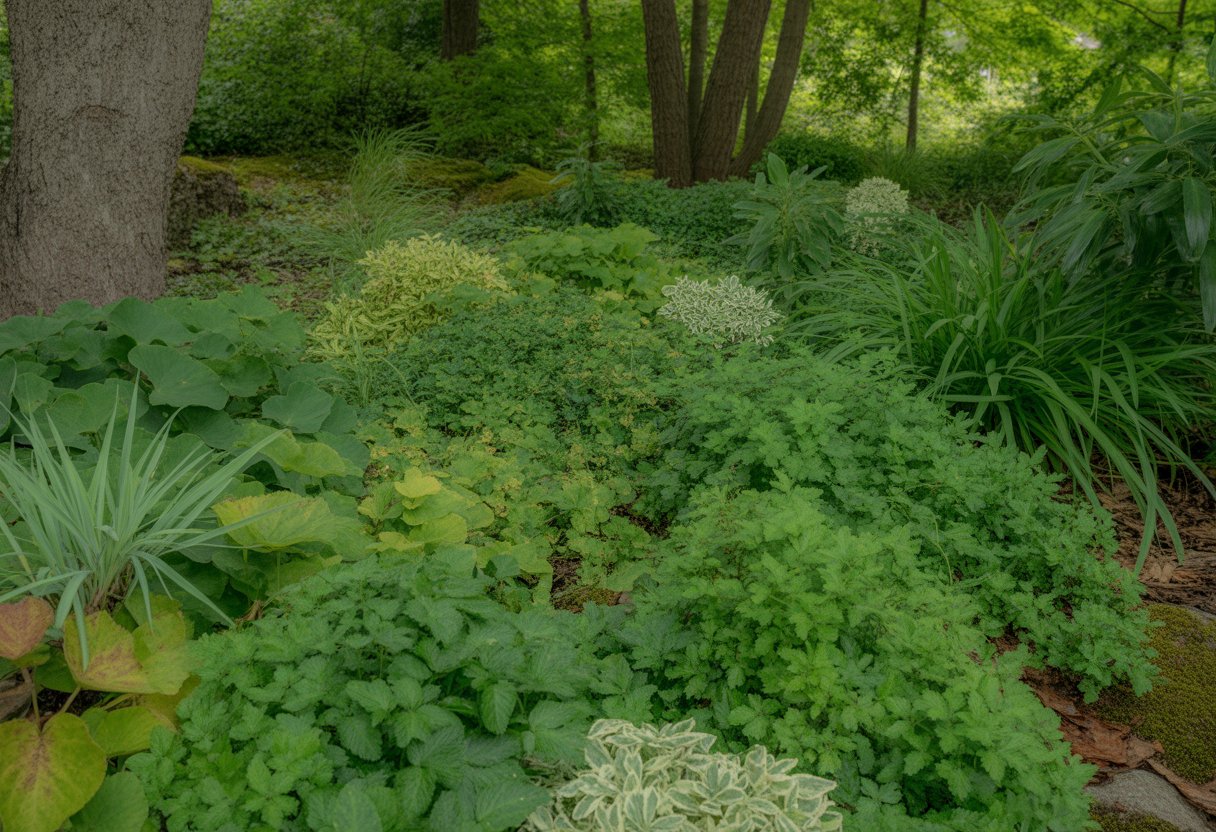Shade Loving Ground Covers Minnesota for Year-Round Garden Success
Creating a thriving shade garden in Minnesota isn’t always easy. Limited sunlight and all sorts of soil quirks can make it tricky.
Choosing the right ground covers for shade is critical if you want a healthy, low-maintenance garden under trees or in those darker corners. The best shade-loving ground covers for Minnesota handle the region’s climate and cover ground reliably without needing full sun.

These groundcovers for shade usually include native plants and tough perennials that hold up in cooler climates. They help keep soil in place, crowd out weeds, and add some much-needed texture or color to those awkward garden spots.
Picking plants that actually like Minnesota weather means your ground cover will last and look good, not just survive. Native options are always worth a look.
Top Shade Loving Ground Covers for Minnesota

These shade-tolerant ground covers really do well in Minnesota. They’re reliable, low maintenance, and each one brings something different—whether it’s the way they spread or the look of their leaves.
Lily of the Valley
Lily of the Valley (Convallaria majalis) is a native perennial that’s perfect for shaded Minnesota gardens. It spreads slowly by rhizomes, forming thick mats that crowd out weeds.
In spring, it shows off small, fragrant white bell-shaped flowers. This plant likes moist, well-drained, organic-rich soils and is happiest under deciduous trees.
Remember, it’s toxic if eaten, so maybe skip it if you’ve got curious kids or pets running around. It’s hardy in USDA zones 2-8.
Ajuga and Ajuga reptans
Ajuga, especially Ajuga reptans, is a tough ground cover with shiny, dark green or purplish leaves. It thrives in shade or partial sun and handles erosion on slopes well.
You’ll see blue to purple flower spikes in late spring. Ajuga spreads fast through stolons, so it’s great for covering uneven ground.
It fits right in with Minnesota’s USDA zones 3-9 and prefers soil that’s moist but drains well.
Hosta Varieties
Hostas are a go-to for Minnesota shade gardens. Their broad, textured leaves and tidy growth habit make them favorites.
There’s a hosta for almost any look—sizes, leaf colors, and patterns vary a ton. Hostas want rich, moist soil and do best with morning sun and afternoon shade.
They handle Minnesota winters (zones 3-8) just fine, but slugs can be a problem. Their foliage steals the show, while their flowers are more of a bonus.
Wild Ginger and Asarum canadense
Wild Ginger (Asarum canadense) is a native ground cover that loves dense shade and moist, fertile soil. It forms thick mats of heart-shaped leaves and spreads slowly.
You’ll spot its unusual, small, brownish flowers close to the ground in spring. Wild ginger resists deer and thrives in USDA zones 3-8.
It’s a solid pick for shaded woodland gardens in Minnesota and helps keep soil moist.
Native and Low-Maintenance Options
Choosing native groundcovers suited to Minnesota’s climate makes life easier and helps local wildlife. These plants need little watering and often work as lawn alternatives.
Native Groundcovers
Native groundcovers like wild ginger (Asarum canadense) and creeping phlox are reliable, shade-tolerant choices. They naturally fend off pests and diseases, plus they’re good for the soil.
These plants spread at a steady pace, creating thick mats that keep weeds out. Once they settle in, you won’t need to fertilize or water them much.
Their roots run deep, so they help keep soil in place on slopes. Honestly, native groundcovers are great if you want something sustainable that still looks nice.
Carex, Sedges, and Carex pensylvanica
Carex species, or sedges, are versatile natives that work in shady spots. They tolerate lots of soil types and moisture levels, making them easy to care for.
Carex pensylvanica (Pennsylvania sedge) stands out with its fine texture and light green leaves—almost like a natural lawn. It grows well in partial to full shade and doesn’t need much mowing.
Sedges grow in clumps, which helps loosen soil and supports helpful insects. They’re adaptable, so if you’ve got tough shady areas, these are worth a shot.
Allegheny Spurge
Allegheny spurge (Pachysandra procumbens) is a native evergreen that handles shade and dry spells. Its glossy, mottled leaves look good year-round, and it puts out small white flowers in spring.
This plant spreads at a moderate pace, forming a thick carpet that stops weeds and holds soil. Allegheny spurge likes well-drained, acidic soils, which are common in Minnesota woods.
You’ll only need to trim it now and then to keep it tidy. It’s a strong option for replacing grass under trees or along shady borders.
Designing and Maintaining Shade Ground Cover Plantings

Getting shade ground covers to thrive takes some planning. Soil, plant choices, and ongoing care all matter.
Moisture, bloom potential in low light, and keeping unwanted growth in check are all part of the challenge if you want a lush Minnesota shade garden.
Soil Moisture and Site Selection
Soil moisture makes a big difference when picking ground covers for shade. Most of these plants like soil that’s moist but not soggy.
If your spot drains poorly, roots can rot, so check your soil before planting. Sites with dappled or filtered shade are easier on plants that can’t take deep shade or bone-dry soil.
Too dry? Add organic mulch to help keep moisture in. If you’ve got heavy clay, mixing in compost helps a lot.
Keep an eye on soil moisture, especially early on. Most Minnesota-adapted ground covers like soil that’s a bit acidic to neutral, so you might need to tweak pH with lime or sulfur based on soil tests.
Low-Light Flowering Selections
Not many ground covers bloom well in deep shade, but Trillium and Virginia bluebells can add subtle flowers to shady gardens. Their blooms are small but brighten things up without needing direct sun.
Plants like Liriope and Ajuga offer interesting leaves and sometimes flowers in low light. Picking varieties with bold or unusual foliage can keep your garden interesting, even when flowers are scarce.
Many shade bloomers flower in early spring before tree leaves block the light. If you want color all season, try mixing plants with different bloom times.
Managing Weeds and Herbicides
Weed control in shady ground cover beds is never fun. Limited sun and dense planting make it tough.
Hand-pulling weeds is safest—ground covers can be delicate. If you need herbicides, use them carefully and only where necessary.
Non-selective herbicides can damage your ground covers, so go for selective ones or just spot-treat. Thick, healthy ground cover crowds out weeds by hogging space and nutrients.
A good layer of mulch also helps stop weed seeds from sprouting and keeps soil moist.
Alternative and Specialty Shade Ground Covers

Alternative ground covers give you options for all kinds of shade, soil, and maintenance levels. Some work in partial shade, others tolerate deep shade or tricky soil.
They come in different textures, colors, and bring interest to the garden at different times of year.
Creeping Thyme and Thymus serpyllum for Shade
Creeping thyme (Thymus serpyllum) is a low, aromatic ground cover that can handle light shade. It likes well-drained soil and moderate moisture, but it’s not too picky.
You’ll get small purple flowers in early summer that attract pollinators. Creeping thyme spreads slowly but forms a nice, thick mat that keeps weeds down.
It’s happiest in full sun but can take up to half shade—so it works on north-facing slopes or under leaf-dropping trees. Just trim it occasionally and don’t overwater, or you might get root rot.
Creeping Phlox and Plumbago in Low Light
Creeping phlox does well in light shade and brings bright spring color, from pink to lavender. It likes well-drained soil and fills spaces between rocks or along paths nicely.
In deeper shade, you’ll see fewer flowers, but the foliage still looks good. Plumbago adapts to partial shade and blooms blue or white for a long stretch.
It needs soil that’s always moist but drains well, and it’s great as a ground cover under trees with dappled light. Both of these plants help hold soil on slopes and bring color to shaded spots.
Ferns for Dense Shade
Ferns really shine in dense, moist shade and acidic soil—just what you find in many Minnesota woodlands. Favorites like Christmas fern and sensitive fern create lush, green carpets.
You barely need to fuss over them, aside from the occasional leaf cleanup and making sure the soil stays moist. Ferns don’t bloom, but their fronds add texture and depth.
They handle heavy shade and help stop erosion, making them perfect for naturalistic or woodland gardens.
Other Uncommon Choices: Ice Plant and Sea Thrift
Ice plant is a succulent ground cover that sometimes pops up in shaded rock gardens. While it usually prefers more sun, a few varieties manage in partial shade if the soil stays sandy and dry.
It brings some flashy foliage and flowers, but honestly, it needs excellent drainage. Without that, it’s probably not going to thrive.
Sea thrift (Armeria maritima) handles poor soils and moderate shade better than you’d expect. Its grass-like foliage and those rounded pink flower clusters show up in late spring.
Sea thrift likes well-drained soil and doesn’t ask for much water. It’s a solid pick for those tricky, borderline shady spots where other ground covers just give up.

